Day 3 versus blastocyst transfer (systematic review)

Blastocyst versus day 3 embryo transfer
Dr. Demián Glujovsky published several papers about the benefits of transferring embryos on blastocyst stage. In 2016, he published a Cochrane systematic review (Glujovsky et al, 2016) and then a second review about this issue at Fertility & Sterility.
There is low quality evidence supporting that blastocyst transfer increases the live birth rate, and moderate quality evidence showing that clinical pregnancy rate is higher in blastocyst transfer than in day 2-3 embryo transfers. (Glujovsky et al, 2016)
Why should a blastocyst transfer be better?
Not all the embryos get to blastocyst stage. Most get to day 2-3, but only some of them cleave until day 5. When you decide to transfer on blastocyst stage, you are picking the more viable embryos. At the same time, when the implantation rate is higher (as occurs with blastocysts), we can decrease the number of embryos to transfer, decreasing the multiple pregnancy rate. This way, a blastocyst transfer helps to have a higher successful number of pregnancies and, at the same time, fewer pregnancy and perinatal complications. Finally, when you freeze embryos on blastocyst stage, you choose to freeze only those that got to that stage (saving money, time and increasing the success chances for a frozen embryo transfer).
To have a good blastocyst rate (percentage of embryos that get to day 5), you need a modern embryo lab, with the best technology, top quality culture media and embryologists that know about it.
In our clinic, we transfer all the cases in blastocyst stage. When we changed our policy in our egg donor program, we increased the clinical pregnancy rates from 50-55% to 60-65%.


